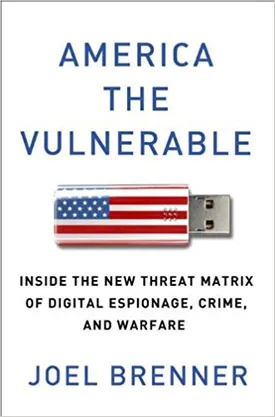America the Vulnerable: Inside the New Threat Matrix of Digital Espionage, Crime, and Warfare by Joel Brenner
America the Vulnerable: Inside the New Threat Matrix of Digital Espionage, Crime, and Warfare by Joel Brenner is a gripping examination of how the United States is facing newfound threats to its security in the 21st century. In today’s world of increasing cyber espionage, cyber crime, and cyber warfare, the US is not only exposed but dangerously vulnerable. Through careful analysis of the unique risks the US faces and the measures it must take to protect itself, Brenner lays out a comprehensive framework for protecting America from these unprecedented threats.
The book begins with an exploration of America’s long history of both espionage and warfare. As with most powers, the US has long prepared for and waged war by intelligence and sabotage—but now these tactics are evolving in dangerous new ways. In the age of the Internet, it's not just nation-states that are capable of waging cyber warfare; criminals, terrorists, and hostile agents of foreign states can all gain access to sensitive files and information. In doing so, they can disrupt businesses, steal identities and intellectual property, and even sabotage military operations.
Brenner argues that the threat posed by digital espionage, crime, and warfare is graver than ever before, and warns that the US must consider digital espionage to be a top risk and vulnerability. Yet, the US is shockingly unprepared for this new threat matrix. The government has been slow to respond to the changing threat, and there's an alarming lack of investment into cyber security capabilities. Furthermore, the US has failed to regulate or adequately protect the vast amounts of sensitive data in its possession, especially classified military and intelligence data.
The book goes on to discuss the various measures the US must take to protect both itself and its citizens. Brenner stresses the need for US government, businesses, and citizens to become much more aware of the risks posed by digital espionage and crime. He also highlights the importance of investing in cyber security capabilities to better protect against these threats. In particular, he recommends the creation of a national cyber guard and the use of cyber-intelligence to detect and respond to digital threats before they can do harm.
Finally, Brenner provides a series of recommendations on how to improve the US’s defenses against digital espionage, crime, and warfare. He emphasizes the need for consistent government oversight and ongoing investment into cyber security measures, as well as the need for businesses and citizens to be constantly alert and vigilant. Furthermore, he argues that while the US must take steps to protect itself, it can only do so if it balances security needs with the protection of civil liberties and democratic ideals.
Overall, America the Vulnerable: Inside the New Threat Matrix of Digital Espionage, Crime, and Warfare provides a comprehensive look at the risks the US faces in the digital age, and makes a compelling case for the urgent need for investment and action. By outlining the multi-faceted threats posed by digital espionage, crime, and warfare, the book equips readers with the understanding and the tools to help protect America’s security against these novel threats.

